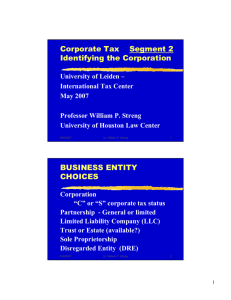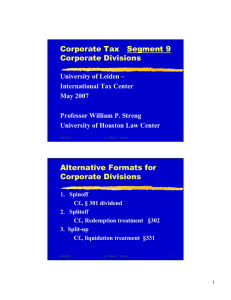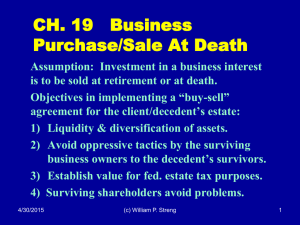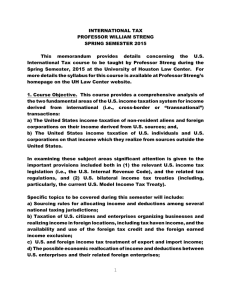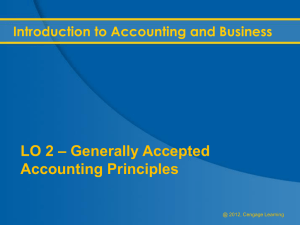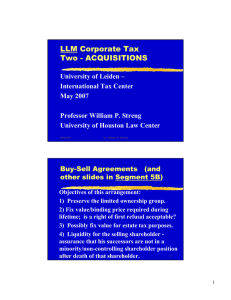LLM Corporate Tax One - CHOICE OF ENTITY
advertisement
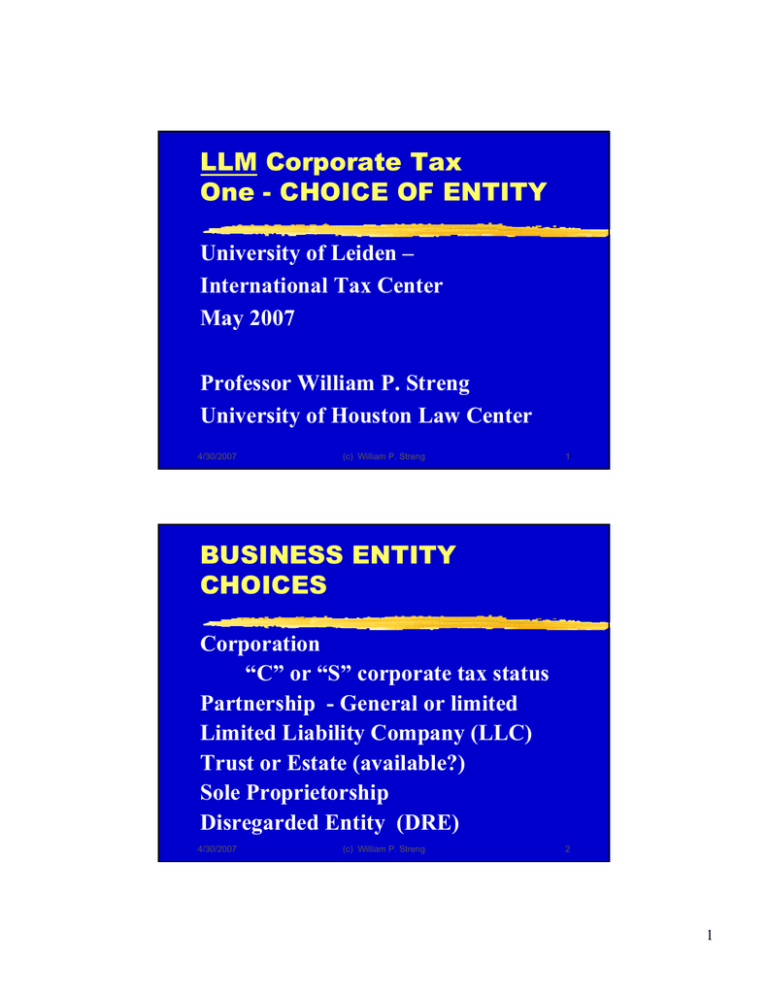
LLM Corporate Tax One - CHOICE OF ENTITY University of Leiden – International Tax Center May 2007 Professor William P. Streng University of Houston Law Center 4/30/2007 (c) William P. Streng 1 BUSINESS ENTITY CHOICES Corporation “C” or “S” corporate tax status Partnership - General or limited Limited Liability Company (LLC) Trust or Estate (available?) Sole Proprietorship Disregarded Entity (DRE) 4/30/2007 (c) William P. Streng 2 1 Definition of “Corporation” Code § 7701(a)(3) Choices of business entities: 1. Regular corporation 2. S corporation 3. Foreign corporation 4. Limited liability company - LLC 5. Limited partnership, including “MLP” 6. General partnership 7. Sole proprietorship (& the “tax nothing”) 4/30/2007 (c) William P. Streng 3 Prior Entity Classification Criteria -Tax Regulations 1) associates 2) business objective 3) continuity of life 4) centralization of management 5) limited liability for debts of entity 6) free transferability of interests - but buysell agreement not limiting transferability. Regs. had bias towards partnership status. 4/30/2007 (c) William P. Streng 4 2 “Check the Box” Regulations Premise: Regulations make the choice of entity optional to the taxpayer. 1) Automatic classification of certain entities as corporations - per se treatment; including enumerated foreign corporations. 2) Default partnership status - an "eligible entity" may elect to the contrary (not in the foreign context, where one party must have 4/30/2007 (c) William Streng must consent).5 unlimited liability; orP.both Additional Entity Classification Issues 1) The “tax nothing” or disregarded entity See Rev. Proc. 2002-69 – community property shareholder status. 2) What tax effect of a change in the number of members of an entity? 3) What income tax effect of elective changes in tax classification of the entity? a) Partnership to corporation? 4/30/2007 (c) William P. Streng 6 b) Corporation to partnership? 3 The “Publicly Traded Partnership” Corporate treatment of a “publicly traded partnership”? IRC § 7704. What is “publicly traded”? Purpose of the exception from corporate status where 90% of more of entity’s income is “passive”, including income from natural resource activities? 4/30/2007 (c) William P. Streng 7 Corporations vs. Partnerships vs. Trusts Reg. § 301.7701-4 - purpose of a trust is to “protect or conserve” property, but not to conduct business. If so, partnership status. Types of trusts: - personal wealth investment and management - oil royalty trusts - equipment leasing trusts 4/30/2007 (c) William P. Streng 8 4 Trust Income Taxation 1) Grantor trusts: Subchapter J, Subpart E, § 671 et. seq. - income taxation to the grantor 2) Nongrantor trusts: Subparts A-D taxation of (a) trust (if no distribution) or (b) beneficiaries to the extent of actual distributions (or required distributions). 4/30/2007 (c) William P. Streng 9 Recognition of the Corporate Entity I.e., is the corporation treated as an entity separate from its shareholders? Bollinger: corporation holding title to real property as an agent for the shareholders of the corporation. Held: Agency status: losses were allowable to the individuals (shareholders of the corporate agency). 4/30/2007 (c) William P. Streng 10 5 National Carbide Factors 1) Corporation operates in the name and for the account of the principal; 2) Corporation binds the principal; 3) Transmits money to the principal; 4) Income attributable to services of the employees of the principal? continued 4/30/2007 (c) William P. Streng 11 National Carbide, cont. 5) Relations with the principal must not be dependent upon the fact that it is owned by the principal; (see Bollinger case discussion) and, 6) Business purpose must be the carrying on of the normal duties of an agent. 4/30/2007 (c) William P. Streng 12 6
